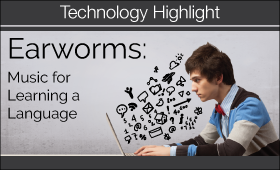Earworms: Music for Learning a Language

By Stefano Maranzana, Ph.D. candidate in Second Language Acquisition and Teaching, Graduate Associate in Teaching Italian at the University of Arizona.
DOI: https://doi.org/10.69732/YINC9900
According to the Merriam-Webster online dictionary, an earworm is “a song or melody that keeps repeating in one’s mind.” Produced by the Berlitz Corporation, Earworms MBT® is a commercial website offering audio CDs, mp3 files or apps for iPhone and Android with language lessons intended for English, French and German speakers. Prices are listed here.
Each language comes in two volumes: Volume 1, the “survival kit,” covers the basics for travelling abroad; Volume 2 provides additional grammar drills and vocabulary for a more advanced level. Each volume includes a booklet covering all the words and phrases spoken in the audio tracks, plus their phonetic renditions. Additionally, the program offers what they call “memory hooks.” To help memorizing certain words or phrases, the voice in the audio tracks suggests similar-sounding words in the learner’s language. For example, in order to learn the Italian for “my name is,” mi chiamo, Earworms MBT® suggests invoking the mental image “my name is Micky Armo,” as a way to link a foreign expression to a more familiar one and facilitate recall. The rationale supporting Earworms MBT®’s method is described at length in this page and is borrowed from linguist Michael Lewis’ methodology (1993). At the core of what Lewis called the Lexical Approach is the idea of language “chunks,” which establish the inventory of a language speaker. Furthermore, music plays an important part in Earworms MBT®’s approach.
The idea behind Earworms MBT® is interesting and original and could be used as supporting ancillary particularly outside the classroom. What I like about this program is that, especially as an app, it may inspire curiosity to younger generations of language learners. It is possible to listen to a free sample of the product by following this link. The test-drive page displays an audio player and a list of links to the fifteen languages offered to the English speakers. By clicking on the link, the user can listen to a 6-minute passage of the program. You can also watch this video.


